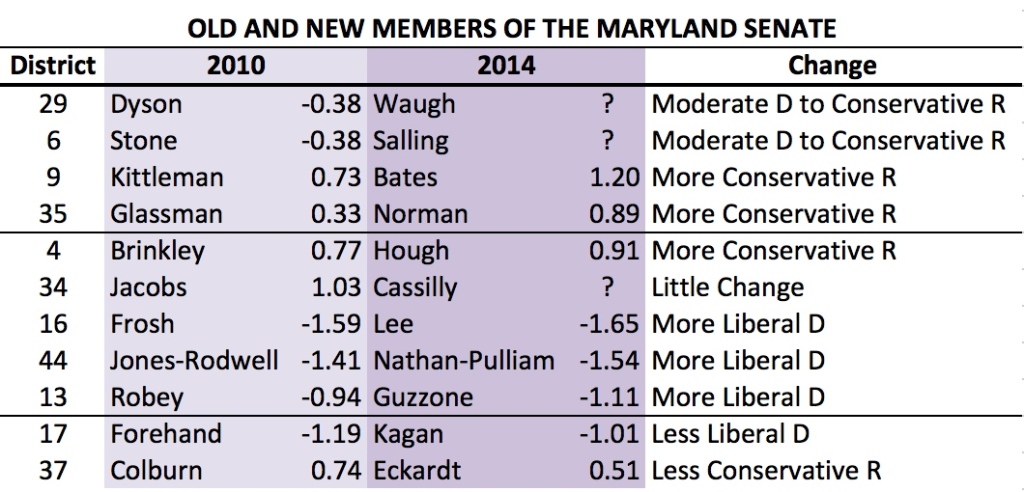Yesterday’s post on Senate races revealed that most contests are safely in the bag for one candidate or another but highlighted the four closest contests in the State. This afternoon, I take a look at races that are likely to go one way but have an outside potential to surprise. In truth, however, most just further illustrate the paucity of competitive Senate races in Maryland this year.
District 3: Young (D) v. Stottlemyer (R), Likely D
Over at Center Maryland, Josh Kurtz views Sen. Ron Young as a potentially vulnerable Democrat. I just don’t see it. Frederick County now has only a slight Republican lean. In the old District 3, Obama won 59% of the vote even in the old district, though O’Malley took just 48% in 2010. Redistricting shed the district’s most Republican territory, leaving it more Democratic.
In 2010, former longtime Frederick Mayor Young defeated incumbent Sen. Alex Mooney, who is now running for Congress in West Virginia. While Young has a well-funded campaign, his Republican opponent, Corey Stottlemeyer, has little cash to spend (<10K) and has sent no direct mail yet.
However, I suppose a surprisingly large Hogan wave combined with too many Youngs on the ballot–his wife, a former Frederick alderman and mayoral candidate, is running for delegate–could result in an upset. Except that it is much more likely that both members of this husband-wife team win.
District 6: Olszewski (D) v. Salling (R), Likely D
Johnny O. isn’t a character from Goodfellas or a member of a 1950s boy band. Instead, he’s a talented two-term delegate who is the junior half of a father-son political dynamic duo–Johnny O. Sr. has served on the Baltimore County Council since 1998.
In the 2010 delegate race, Johnny O. came in ahead of his fellow Democrats in this increasingly competitive district. But southeastern Baltimore County has not been immune to the attractions of GOP candidates. McCain won 54% in District 6 in 2008, and Ehrlich won 60% in 2010. Brown is not expected to perform well here.
I’d be shocked if Johnny O. didn’t become Sen. Johnny O. (J Yo?). Beyond his excellent father-son personal political brand, his opponent is not well funded. Nevertheless, a rash of straight ticket voting could possibly make this one to watch.
District 9: Frederic (D) v. Bates (R), Likely R
Democrats saw an opportunity to pick up a seat in increasingly Democratic Howard County when incumbent Sen. Alan Kittleman decided to run for county executive. But it looks likely that Del. Gail Bates, who has served in the House since 2002, will keep this district in Republican hands.
Things might have gone differently had the Democrats taken advantage of redistricting and been willing to rejigger the lines radically. However, the redistricting map kept the most Republican areas of Howard united in a single district and still contains a bit of uber-Republican Carroll County.
Though Democrat Ryan Frederic’s campaign is better funded, Bates’ campaign has had healthy financial support. Moreover, Bates’ opponent doesn’t have the name recognition or campaign experience that come from her multiple election victories.
Though Bates would probably prefer that popular Howard County Executive Ken Ulman not be #2 on the Democratic ticket, she’ll benefit from Kittleman leading the Republican charge on the local level. In a better Democratic year and with more demographic change, Frederic might have a better shot but a loss by Bates would be a real upset right now.
District 12: Kasemeyer v. Pippy, Likely D
The only reason that this district is on the likely rather than safe list is that Sen. Ed Kasemeyer won in 2010 with under 60% of the vote. However, the Chair of Budget and Tax unsurprisingly has a well-funded campaign. While Pippy has more than a token amount in his campaign account, it’s not really enough to mount a viable campaign against an entrenched incumbent.
I received some needed push back from my post yesterday declaring two seats safe for Democrats. Specifically, Sen. John Astle in District 30 has dicey turf for Democrats that will go for Hogan and Astle has had close races in the past. However, my cursory examination of campaign finance reports suggests an opponent without sufficient resources.
In District 8, Sen. Kathy Klausmeier also has swingy turf that could cause trouble for Democrats in a bad year but her opponent filed an affidavit indicating a lack of money. If the Republican Senate campaigns are more vibrant than I realize in these districts, let me know. No doubt both are concerned about an undertow due to low support for Lt. Gov. Brown in their area.

